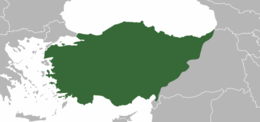
Back Anatolië Afrikaans Kleinasien ALS አናቶሊያ Amharic Peninsula d'Anatolia AN Læsse Asia ANG Anatolia ANN الأناضول Arabic ܐܢܛܘܠܝܐ ARC اسيا الصغرى ARZ Anatolia AST
Anadolu (Turkish) | |
|---|---|
 Satellite imagery centred on Anatolia, which accounts for the bulk of modern-day Turkey | |
 Map of Anatolia (dark green), which is delineated by an imprecise line from the Gulf of Alexandretta to the Black Sea[1][2] | |
| Etymology | "The East" (from Greek: Ἀνατολή, Anatolḗ) |
| Geography | |
| Location | West Asia |
| Coordinates | 39°N 35°E / 39°N 35°E |
| Type | Peninsula |
| Area | 537,886 km2 (207,679 sq mi)[3] |
| Capital and largest city | Ankara (pop. 5,803,482) |
| Demographics | |
| Demonym | Anatolian |
| Languages | |
| Ethnic groups | |
| Additional information | |
| Time zone | |
Anatolia (Turkish: Anadolu), also known as Asia Minor,[a] is a peninsula in West Asia that makes up the majority of the land area of Turkey. It is the westernmost protrusion of Asia and is geographically bounded by the Mediterranean Sea to the south, the Aegean Sea to the west, the Turkish Straits to the northwest, and the Black Sea to the north. The eastern and southeastern limits have been expanded either to the entirety of Asiatic Turkey[1] or to an imprecise line from the Black Sea to the Gulf of Alexandretta.[2] Topographically, the Sea of Marmara connects the Black Sea with the Aegean Sea through the Bosporus and the Dardanelles, and separates Anatolia from Thrace in Southeast Europe.
During the Neolithic, Anatolia was an early centre for the development of farming after it originated in the adjacent Fertile Crescent. Beginning around 9,000 years ago, there was a major migration of Anatolian Neolithic Farmers into Europe, with their descendants coming to dominate the continent as far west as the Iberian Peninsula and the British Isles.
The earliest recorded inhabitants of Anatolia, who were neither Indo-European nor Semitic, were gradually absorbed by the incoming Indo-European Anatolian peoples, who spoke the now-extinct Anatolian languages. The major Anatolian languages included Hittite, Luwian, and Lydian; other local languages, albeit poorly attested, included Phrygian and Mysian. The Hurro-Urartian languages were spoken throughout Mitanni in the southeast, while Galatian, a Celtic language, was spoken throughout Galatia in the central peninsula. Among the other peoples who established a significant presence in ancient Anatolia were the Galatians, the Hurrians, the Assyrians, the Armenians, the Hattians, and the Cimmerians, as well as some of the ancient Greek tribes, including the Ionians, the Dorians, and the Aeolians. In the era of classical antiquity (see Classical Anatolia), the Anatolian languages were largely replaced by the Greek language, which came to further dominate the region during the Hellenistic period and the Roman period.
The Byzantine period saw the decline of Greek influence throughout the peninsula as the Byzantine–Seljuk wars enabled the incoming Seljuk Turks to establish a foothold in the region. Thus, the process of Anatolia's Turkification began under the Seljuk Empire in the late 11th century and continued under the Ottoman Empire until the early 20th century, when the Ottoman dynasty collapsed in the aftermath of World War I. Between 1894 and 1924, millions of non-Turkic peoples and Christians were suppressed and removed by the Ottoman Turkish authorities from the bulk of the area of modern-day Turkey. Nonetheless, a variety of non-Turkic languages continue to be spoken by ethnic minorities in Anatolia today, including Arabic, Kurdish, Neo-Aramaic, Armenian, the North Caucasian languages, Laz, Georgian, and Greek.
- ^ a b
- McColl 2014, p. 922: "Thrace, its European area, is about the size of VERMONT at 9,412 square mi (24,378 square km). Its Asian area (Asia Minor) is called Anatolia and covers 291,971 square mi (756,202 square km)"
- Cohen 2008, p. 125: "Anatolia, [Gr.=sunrise], Asiatic part of Turkey; its area covers 97% of all Turkey"
- Tockner, Uehlinger & Robinson 2009: "About 97% of the country is in Asia Minor (Anatolia) and 3% in Europe (Thrace)"
- "Turkey". The World Factbook. Central Intelligence Agency. Retrieved 20 February 2024.: "the 97% of the country in Asia is referred to as Anatolia"
- "Anatolia". Encyclopedia Britannica. Retrieved 29 February 2024.: "Anatolia, the peninsula of land that today constitutes the Asian portion of Turkey"
- Steadman & McMahon 2011, p. 466
- Howard 2016, p. 7
- Helen Chapin Metz, ed. (1995). "Turkey: A Country Study | Geography". Washington: GPO for the Library of Congress. Retrieved 31 May 2024.: "The Asian part of the country is known by a variety of names--Asia Minor, Asiatic Turkey, the Anatolian Plateau, and Anatolia (Anadolu)"
- ^ a b Hopkins, Daniel J.; Staff, Merriam-Webster; 편집부 (2001). Merriam-Webster's Geographical Dictionary. Merriam-Webster. p. 46. ISBN 978-0-87779-546-9. Archived from the original on 28 November 2021. Retrieved 18 May 2001.
Anatolia: The part of Turkey in Asia equivalent to the peninsula of Asia Minor up to indefinite line on E from Gulf of Iskenderun to Black Sea comprising about three fifths of Turkey's provinces
- ^ Stephen Mitchell (6 July 1995). Anatolia: land, men, and Gods in Asia Minor. Vol. 2. Oxford University Press. ISBN 0198150296.
- ^
- KONDA 2006, p. 19
- Comrie 2018, p. 537
- ^ a b "Turkey (Turkiye)". The World Factbook. Central Intelligence Agency. Retrieved 9 October 2024.
- ^ a b KONDA 2006, p. 17
Cite error: There are <ref group=lower-alpha> tags or {{efn}} templates on this page, but the references will not show without a {{reflist|group=lower-alpha}} template or {{notelist}} template (see the help page).